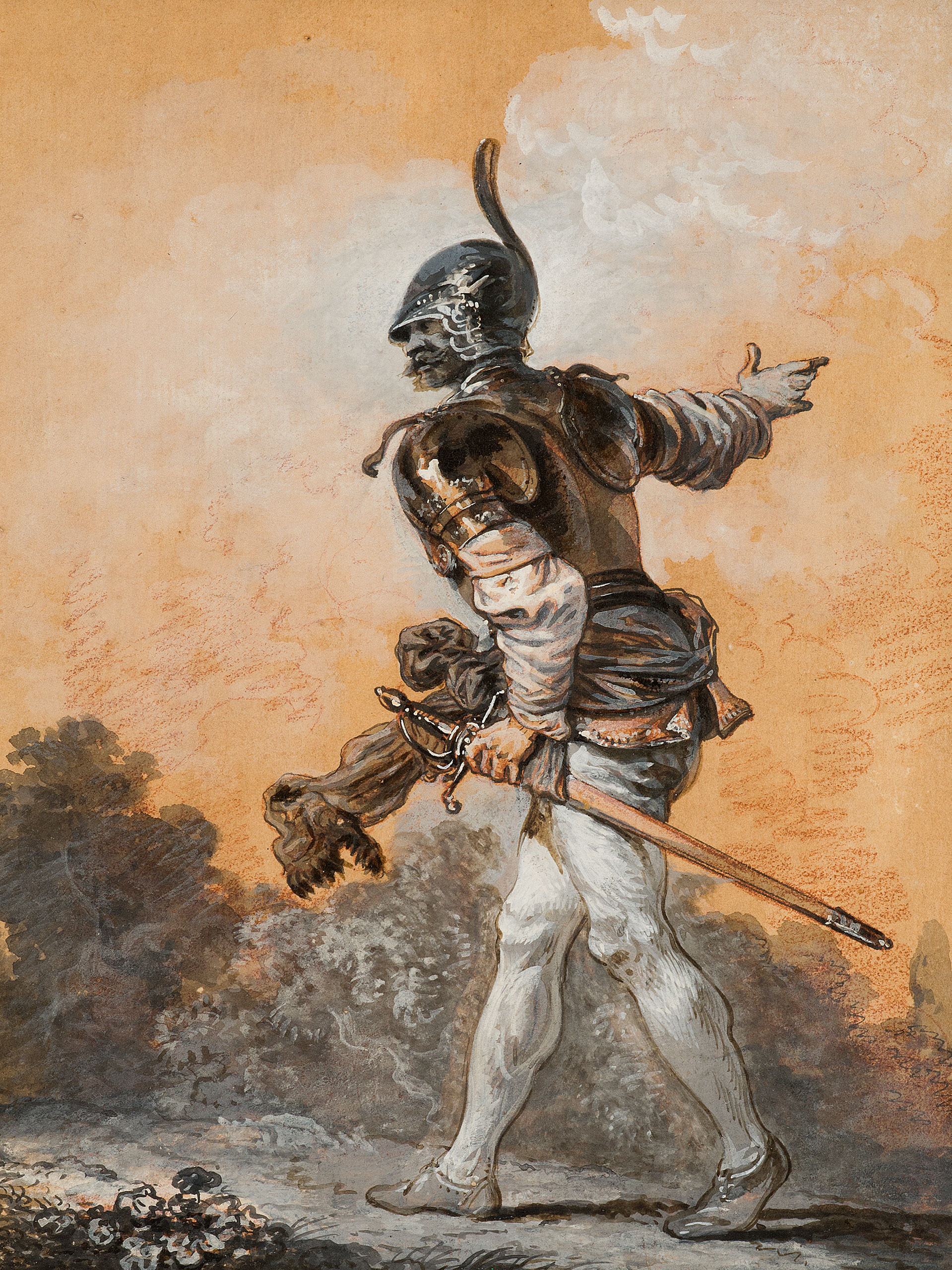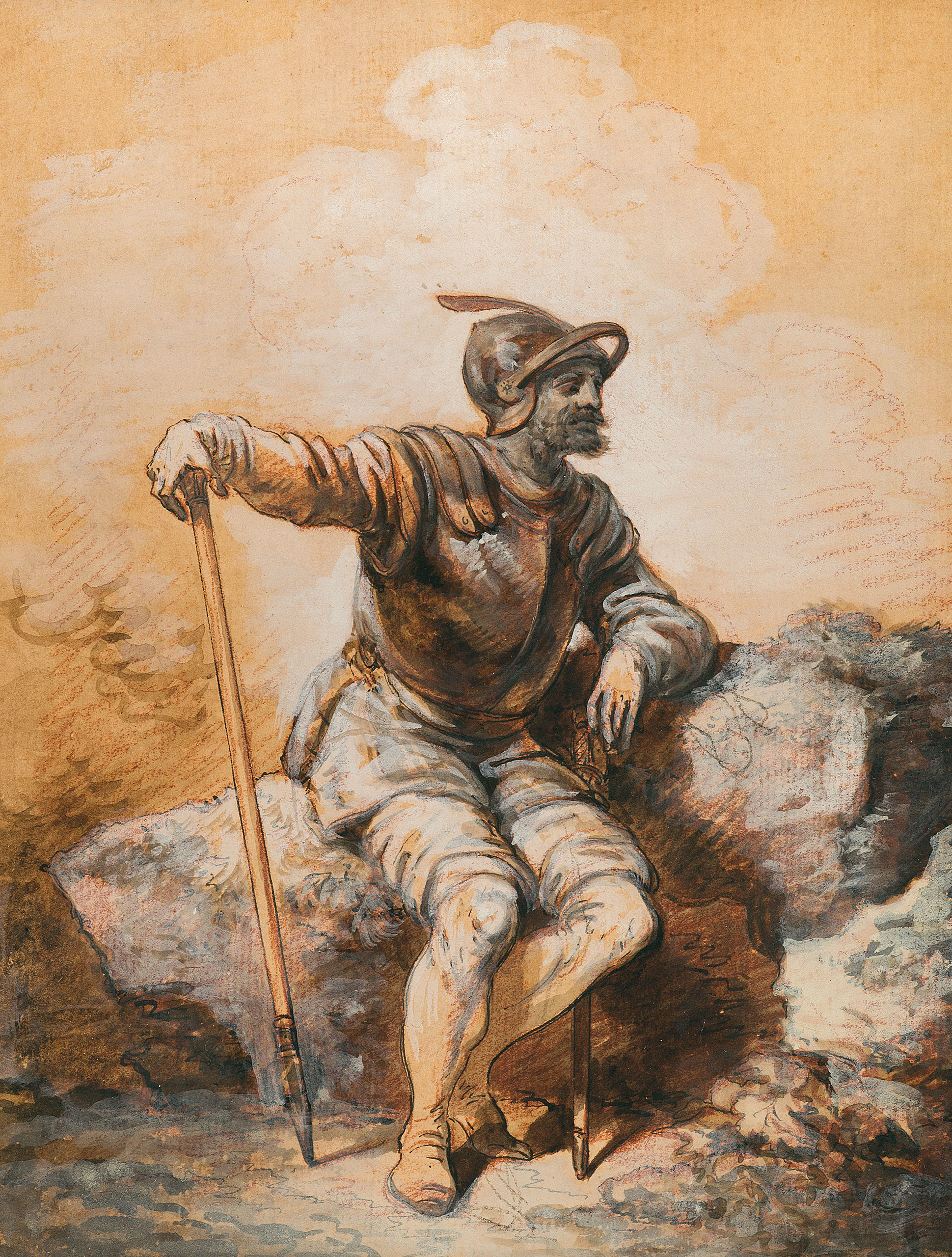Norblin de La Gourdaine
Jean-Pierre
A standing soldier, sword at his side, pointing behind him
A seated soldier, hand resting on a spear
A standing soldier, sword at his side, pointing behind him
A seated soldier, hand resting on a spear
Black chalk, red chalk, grey and brown wash with white gouache highlights on buff paper, a pair.
197 x 152 mm (7 3/4 x 5 15/16 in.)
Literature
Konrad Niemira, Jean-Pierre Norblin de la Gourdaine (1745-1830). Catalogue of Paintings, translated by A.-M. Fabianowska, Varsovie, Adam Mickiewicz Museum of Literature, 2023, fig. 15-16.
Engraver, painter, and draftsman, Norblin de la Gourdaine apprenticed with Jacques Philippe Caresme and trained in the workshop of Francesco Casanova from 1763 to 1771. He probably replaced Philippe Jacques Loutherbourg who had just left his master in uproar to form a cabal against him. Either as a student or collaborator with Casanova, Norblin also took courses at the Royal Academy of Painting and Sculpture and submitted sketches in 1769. It was no doubt because he found himself with few prospects in Paris and little support in a competitive academic environment, that he decided to go to London and then to Spa around 1771-17721. In 1774, he moved to Poland on the invitation of Adam Kazimir Czartoryski and his wife, whom he had met during their trip to Paris and for whom he worked regularly. Norblin married in Poland and pursued his career, working for different families, notably the Radziwills, executing a painting in the style of Watteau and some genre scenes for King Stanislas Auguste. Norblin enjoyed some success with his scenes of fêtes galantes (romantic celebrations) inspired by the Watteau and Hubert Robert, as well as with representations of Polish historical and political events, such as the Kosciuszko uprising. However, he was mainly appreciated for his drawings that sold easily at a fairly high price on the Polish market and often in small groups of three to five works2. This is the case for our two works that once belonged to a larger series. Norblin remained in Poland for around thirty years but finally returned to France. One of his Polish students was the famous Aleksander Orlowski, who like Norblin, would be strongly influenced by Salvator Rosa and Dutch painters, most notably, Rembrandt.
Without copying directly, these two drawings are inspired by Salvator Rosa’s “figurine d’aquaforte (Figurine)3” that represents characters, usually soldiers, standing or seated in various positions. These etchings exerted a considerable influence on 18th century artists, particularly, but not only, in England. It was most likely in the workshop of his master Casanova, born and trained in London, that Norblin discovered them. Inventive in his compositions, vigorous in his line and fully mastering the pictorial effects that the mixture of white gouache, grey wash and red chalk allows, the artist produced works intended to be sold in series. In fact, there are several other gouaches of the same subject, size and technique, which must have formed a homogeneous group, probably separated at the discretion of inheritance requests and sales: The Watcher standing with his arm raised towards the horizon, The Soldier seated in front of his shield and The Soldier seated, his shield behind his back were put up for sale in 19984. Two of these gouaches are dated 1776, which allows us to date the series from the beginning of his Polish period. Our warmest thanks go to Konrad Niemira who pointed out another series of soldiers executed in the same highly pictorial technique, but leaning towards grisaille and dated 1780. Three of them are preserved in the collections of the Royal Castle in Warsaw (ZKW-dep. FC/441/ab, ZKW-dep. FC/472/ab, ZKW-dep. FC/441/ab) and the fourth one in a private collection.
-
K. Niemira, “Your money or your life or why Jean Pierre Norblin de la Gourdaine left Paris”, Quart, n° 2 (56) 2020, (referenced on academia.edu).
-
Op.cit., p. 105.
-
This is how Salvator Rosa himself designates them in a letter dated October 14th, 1656. (U. Limentani, “Salvator Rosa, nuovi studi e ricerchi”, Italian Studies, 1953, p. 53, n° 3; R; Wallace, The Etchings of Salvator Rosa, Princeton New Jersey, Princeton University Press, 1979, p. 12; A. Hoare, The Letters of Salvator Rosa, London, Harvey Miller Publisher, 2018, Vol. 1, p. 463).
-
Paris, sale of Rieunier-Bailly, Pommery, 9 March 1998, lot 15, 16 and 17. Only lot 15, A seated solider with his shield behind his back, is slightly smaller in size (165 x 120 mm).


